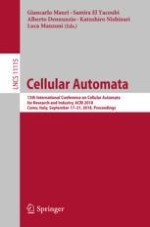2018 | Book
Cellular Automata
13th International Conference on Cellular Automata for Research and Industry, ACRI 2018, Como, Italy, September 17–21, 2018, Proceedings
Editors: Giancarlo Mauri, Samira El Yacoubi, Alberto Dennunzio, Katsuhiro Nishinari, Luca Manzoni
Publisher: Springer International Publishing
Book Series : Lecture Notes in Computer Science
